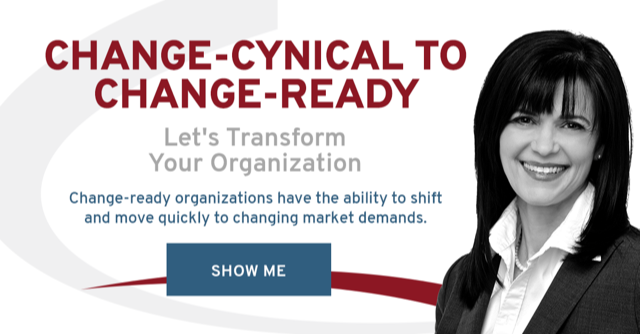By: Dr. Dawn-Marie Turner
Change is uncomfortable, and can be disruptive for both leaders and employees. Taking this one simple, but often overlooked, step at the beginning will help reduce the chaos. It will also help you achieve the value intended.
One of the shows I used to like on the food network was Restaurant Makeover. The premise of the show was simple. A restaurant owner puts up half of the money to makeover her restaurant. The show puts up the other half of the money.
But there’s a catch. To get the show’s half of the money the owner must give full control to the designer and his crew. That’s why for me it’s no surprise that in every episode the owner panics. She doubts the decision, and the makeover is at risk of failure.
A similar type of panic happens with organizational change. But the consequences for your organization are quite different. It is critical you know what to do to reduce and guide your employees through the uncertainty of change.
In the show, the owner’s panic always gives way to enthusiasm and gratitude for the designer’s help. For your organization, you are more likely to experience a derailed and failed change initiative.
Uncertainty Causes a Threat Response in Our Brain
The most difficult moment for the restaurant owner is when she sees her demolished restaurant. With no vision of the new design, all she sees is chaos and disorder. All she feels is fear, loss, and self-doubt. Her lack of insight into the new design causes her brain’s natural threat response to kick into high gear.
The same thing happens when leaders launch a change without a clearly defined intended outcome. Or they fail to ensure the people affected know and believe in the destination.
 In the show, the designer reassures the restaurant owner and the makeover continues. That’s not what happens during organizational change. Your employees, faced with the same situation are more likely to try to stop or slow down the change.
In the show, the designer reassures the restaurant owner and the makeover continues. That’s not what happens during organizational change. Your employees, faced with the same situation are more likely to try to stop or slow down the change.
The threat-reward response in times of uncertainty is normal. Leaders who don’t understand this response make the situation worse. How? Because they interpret the behaviours associated with this normal response as resistance. They then push the change through with a resistance mentality.
This type of approach heightens the threat response. It raises the risk your change effort will not achieve the desired outcome.
Role of leadership is to recognize and reduce the uncertainty
Letting go is one of the most difficult aspects of any change. That’s because change requires us to leave the comfort of something we know. It requires us to move toward an unfamiliar space before we are certain it will be comfortable. We enter a kind of no man’s land and our brains are hardwired to dislike this type of uncertainty.
The amount of uncertainty each of us can handle is different. But research has shown the brain treats any level of uncertainty as a threat. This same research also showed that increasing the level of certainty triggers our brain’s reward response[1]. Our reward response serves as a counter balance to the threat response.
A critical role of leadership during change is to reduce the level of uncertainty of change to its lowest possible level.
A clear, concise, and concrete intended outcome helps reduce uncertainty
One way you can decrease the uncertainty of change is to ensure every change has a destination. I call this the intended outcome. An intended outcome creates a picture of the destination. The intended outcome also helps to create trust and elicit strong positive emotions among change-recipients.
Your intended outcome should be clear, concise, concrete, and written down. Writing it down helps to clarify your thinking. It also provides stability when like the restaurant owner, all your employees can see is the disorder of the change, and feel a sense of loss. A written intended outcome helps to re-focus our attention on the destination.
Some of the drama in the Restaurant Makeover show resulted because the owner didn’t know the outcome. She had no idea what the designer was planning. Although that may make for good television (some would argue it doesn’t) it definitely doesn’t lead to healthy organizational change.
Everyone affected by the change needs knowledge of the intended outcome. They also need the opportunity to explore, understand and make sense of it. This can’t be done via email. To do this you need to make time for people to take part in the conversations about the change. We use conversation to make sense of our world.
It’s easy to overlook this time when you are in a rush to “get it done”, but that’s a mistake. Ensuring (early in the launching of any organizational change) that people know, understand, and believe in the outcome saves time and reduces your risk.
Helping you turn change from a liability to an asset
[1] Rock, D., & Cox, C. (2012). SCARF in 2012: updating the social neuroscience of collaborating with others. NeuroLeadership Journal(4).



